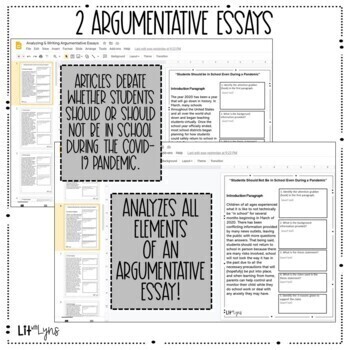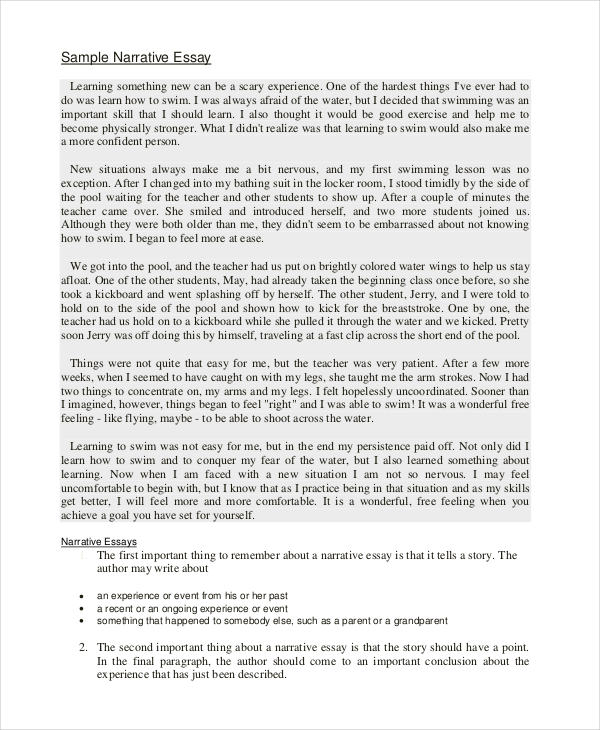
Creative Learning-Personal Narrative Essay. Before 7th grade, I never actually believed in bad things. I just didn’t think of them as things that actually happened to people. I don’t even know why I thought that, I was actually a pretty nice I had a somewhat unremarkable life, except for my mom being gone. I didn’t and still don’t know how she died · Teach that a narrative has characters, conflict, and a solution. A narrative is a story, or a series of events told in a sequence. Narratives feature a character or characters who face a conflict 94%(18) A narrative essay gives writers a chance to write about their personal experiences. It is just like a short story; the only difference is, it follows a proper structure. When you write a narrative essay, you tell a story to your reader. The story could be real, or it could be fictional, but it is defined from a particular perspective. Narrative essay definition
How to Write a Narrative Essay | Example & Tips
Last Updated: June 6, References. This article was co-authored by Christopher Taylor, PhD. Christopher Taylor is an Adjunct Assistant Professor of English at Austin Community College in Texas.
He received his PhD in English Literature and Medieval Studies from the University of Texas at Austin in This article has been viewed 15, times. Narrative writing is fun to teach, but it can also be a challenge! Whether you need to teach college or grade school students, there are lots of great options for lessons.
Learning narrative essay by getting your students familiar learning narrative essay the genre, learning narrative essay, then use in-class activities to help them practice creating their own narratives. Once your students understand how narratives work, assign a narrative essay for students to demonstrate and hone their skills. If you want to show a film but you are short on time, show learning narrative essay short film or sketch comedy clipsuch as something from a channel you like on Youtube.
Choose something that will grab your students' attention! Make it your goal to do 1 activity in class learning narrative essay day! This will help to ensure that your students are getting lots of exposure to what a narrative is and how it works before they write their own narratives. For a creative way to showcase your students' stories, have them to transform their essays into a different format and share it with the class!
For example, your students could turn their essay into a podcast, short film, or drawing, learning narrative essay.
Log in Social login does not work in incognito and private browsers. Please log in with your username or email to continue. wikiHow Account. No account yet? Create an account. Community Dashboard Write an Article Request a New Article More Ideas Edit this Article. Courses New Tech Help Pro New Expert Videos About wikiHow Pro Upgrade Sign In. Home Random Browse Articles Courses New About wikiHow Easy Ways to Help Approve Questions Fix Spelling Quiz App More Things to Try We use cookies to make wikiHow great.
By using our site, you agree to our cookie policy. Cookie Settings. wikiHow is where trusted research and expert knowledge come together. Learn why people trust wikiHow. Categories Education and Communications Writing How to Teach Narrative Writing.
Download Article Explore this Article parts. Related Articles, learning narrative essay. Co-authored by Christopher Taylor, PhD Learning narrative essay Updated: June 6, References. Part 1, learning narrative essay. Teach that a narrative has characters, conflict, and a solution. A narrative is a story, or a series of events learning narrative essay in a sequence.
Narratives feature a character or characters who face a conflict and must work to find a solution. A narrative may be fiction or non-fiction, learning narrative essay. Assign model essays, learning narrative essay, videos, and podcasts. Giving students examples of narratives to read, watch, and listen to will help them to understand the genre better. Choose narrative models that are age-appropriate for your students.
Read, watch, and listen to models in class and have students read some on their own. Go to source Have your students read narrative essays, such as "My Indian Education" by Sherman Alexie, "Shooting an Elephant" by George Orwell, "Learning to Read" by Malcolm X, or "Fish Cheeks" by Amy Tan.
Show your students a movie, such as Moana or Frozen and then plot out the structure of the story with your students. Have your students listen to a podcast or radio segment that features a short narrative, such as the Modern Love podcast or NPR's "This I Believe" series. Learning narrative essay If you want to show a film but you are short on time, show learning narrative essay short film or sketch comedy clipsuch as something from a channel you like on Youtube.
Discuss models in class to identify the features of narratives. Your students will need guidance as they look at models of narrative, so set aside 1 or 2 class sessions to discuss model narratives, learning narrative essay.
Ask students questions to help them better understand what makes these models good examples of narrative, learning narrative essay. Some questions you might ask learning narrative essay students include: [6] X Research source Who are the characters in this story? What are they like? How can you tell? Who is telling the story? What happens to the characters? How do they work towards a solution to the problem? Where and when does the story take place?
What is the mood of the story? Map out the plot and characters in model essays. Another way to help students see the progression of a narrative is to draw it out on a chalkboard or whiteboard.
Start with what happens in the beginning of the story and move through the story paragraph by paragraph to map it out. Ask students questions as you go and encourage them to help you create the map. How does the author introduce the learning narrative essay The characters?
Then, move to the body paragraphs to identify how the story develops. What happens? Who does it happen to? How do the characters respond? Finish your map by looking at the conclusion to the story, learning narrative essay. How is the conflict resolved? What effect does this resolution have on the characters in the story? Part 2. Ask students to contribute a word or sentence to a story.
Telling a story 1 word or 1 sentence at a time is a fun way to help students understand the basic meaning of a narrative. Start a story that your students can build onto by saying 1 word, and then going around the room and having each student contribute a word.
After doing this exercise successfully a couple of times, have each student contribute a sentence instead. You might also give the story more structure by giving your students a model to follow. For example, you might require them to follow a format, such as this one: "The-adjective-noun-adverb-verb-the-adjective-noun. Have students write a paragraph and let their classmates add to it. For a more advanced way to have students collaborate on a narrative, have each student write the first paragraph of a story.
Then, ask the students to pass their paragraph to the right so that their neighbor can add onto it. After the next student has added a paragraph, they would then pass the sheet of paper to the next student, and so on until 5 or 6 students have contributed a paragraph.
Return the learning narrative essay to the student who wrote the opening paragraph so they can see how other people continued their story, learning narrative essay. Ask students to share how their story progressed after they passed it to their neighbor, learning narrative essay. Instruct students on learning narrative essay versus telling in their stories.
An important goal of narrative writing is to use dialogue and details to show readers what the characters are thinking and feeling instead of simply telling readers about these details. Explain the difference to your students by providing them with examples of what showing versus telling looks like. Before she went inside, she turned, shot me a furious look, and shouted, learning narrative essay, 'I never want to see you again!
A great way to practice this concept is to give students a plot point or have them create their own. Then, have the students work on showing the plot point using only dialogue. Provide questions to help students develop their characters. Write and distribute a list of questions meant to help students flesh out the details of their characters.
This will make it easier for them to show readers rather than telling them what the person was like. Some questions you might include in this handout might be: [11] X Research source Learning narrative essay does the character look like?
Other distinguishing features? What mannerisms does the person have? Any nervous ticks? How does their voice sound? What is their personality like? Is the person an optimist or pessimist?
Reflective Essay (Examples, Introduction, Topics) - EssayPro
, time: 9:50Creative Learning-Personal Narrative Essay Essay on Personal Life

· Narrative essays test your ability to express your experiences in a creative and compelling way, and to follow an appropriate narrative structure. They are often assigned in high school or in composition classes at university. You can also use these techniques when writing a personal statement for an application Narrative Essay Writing - Definition, Tips, and Examples A personal narrative essay is considered very good when it is expressive, and the reader enjoys your personal narrative. The key to writing an amazing personal narrative is to use sensory details as much as possible. An excellent narrative essay doesn't tell what happened. Instead, it shows what happened precisely and how you have felt at that moment
No comments:
Post a Comment